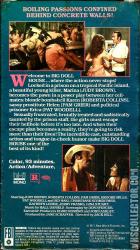Big Doll House
Catalog Number
4050
-
Primary Distributor (If not listed, select "OTHER")
Catalog Number
4050
Primary Distributor (If not listed, select "OTHER")
Release Year
Country
N/A (NTSC)
N/A | N/A | N/A
N/A | N/A
Big Doll House (1971)
Additional Information
Additional Information
Their bodies were caged, but not their desires. They would do anything for a man - or to him.
Soft young girls behind hard prison bars
Boiling passions confined behind concrete walls
Naked lust that builds to a climax of death
White skin on the black market
The dirty dolls of devil's island. You can meet them for a price!
Jack Hill directed this alternately brutal and campy look at desperate women behind bars. An American named Collier (Judy Brown) has been convicted of murder in the Philippines and is sentenced to a grim women's prison in the jungle, where a mysterious German woman, Miss Deitrich (Christiane Schmidtmer), is the warden, and her head guard, sadistic Lucian (Katheryn Loder), keeps her charges in line through intimidation and violence. Collier shares a cell with tough-talking bisexual prostitute Grear (Pam Grier), hard-boiled political prisoner Bodine (Pat Woodell), thick-skinned but good-humored Alcott (Roberta Collins), drug-addicted Harrad (Brooke Mills), and tight-lipped Ferina (Gina Stuart). Bodine's boyfriend is the leader of an underground revolutionary faction, and when she learns he and his comrades are in danger, she begins to plot an escape for herself and her cellmates, with travelling peddlers Harry (Sid Haig) and Fred (Jerry Frank) becoming her unwitting collaborators. Meanwhile, Lucian is stepping up her torture of the prisoners at the behest of a mysterious masked stranger, and Collier is determined to find out who is behind the systematic brutality. The Big Doll House was the first "Women In Prison" exploitation epic produced for Roger Corman's New World Pictures; it was a big hit on the dive-in and grind house circuit, and spawned dozens of imitations (which are still being produced today). By the way, that's Pam Grier singing the theme song!
The Big Doll House is a 1971 women in prison film starring Pam Grier, Judy Brown, Roberta Collins, Brooke Mills, and Pat Woodell. The film follows six female inmates throughout daily life in a gritty, unidentified supra-tropical prison. Later the same year the film Women in Cages featured a similar story and setting, much the same cast, and was shot in the same abandoned prison buildings. A non-sequel follow-up, titled The Big Bird Cage, was released in 1972.[3]
Collier (Brown) enters prison, having been found guilty of killing her husband. She is introduced to the beautiful occupants of her cell, in for crimes ranging from political insurgency to heroin addiction. The women often clash, which leads to their torture by sadistic guard Lucian (Kathryn Loder). The torture ceremonies are viewed by an impassive cloaked figure.
Collier's cellmates Alcott and Bodine (Collins and Woodell) plan to escape. Collier and another cellmate Ferina (Gina Stuart) agree to go along. Assisting is their other lesbian cellmate Grear (Pam Grier), though there are doubts Grear's heroin addict girlfriend Harrad (Brooke Mills) will be equipped to escape.
Ferina, Alcott and Bodine break from the solitary confinement sauna and take their revenge on Lucian. The escapees wield guns, attitude, and sexuality to free themselves.
During their escape they round up various personnel from the prison as hostages, taking elegant prison warden Miss Dietrich (Christiane Schmidtmer), sympathetic prison medic Dr Phillips (Jack Davis), and two local men regularly allowed access to the prison to sell market produce, Harry (Sid Haig) and Fred (Jerry Franks).
This was one of the first films made by B movie giant Roger Corman for his company New World Pictures. According to Stephanie Rothman, Corman originally purchased a screenplay by James Gordon White, which he then asked to be rewritten. Rothman says she, her husband Charles S. Swartz and New World story editor Frances Doel pitched story proposals to Jack Hill, who did not like any of them. They then plotted a new storyline themselves and hired Don Spencer to write the screenplay. Rothman also says that Corman wanted her to direct the picture but she turned it down so Corman hired Jack Hill instead.[4]
John Ashley says Corman originally intended to make the film in Puerto Rico but he persuaded them to make it in the Philippines. Ashley and his partners went on to put up the above the line part of the budget, with Corman providing the rest.[5]
The tag line "Their bodies were caged, but not their desires. They would do anything for a man. Or to him." encapsulates the rather contradictory air expressed by the inmates as they yearn for freedom of multiple kinds; sexual, political, and perhaps ideological — while simultaneously acting as agent provocateur. As a drive in film of the first order, it retains an energetic over an intellectual bent, and thus avoids serious consideration of or accuracy in portraying the actual situation of female American prisoners, instead fulfilling the genre characteristics of Hollywood's women in prison films. Director Jack Hill later made Coffy, a blaxploitation film with Grier which is based on personal vendetta
Release Date: August 1971
Distrib: New World Pictures
Soft young girls behind hard prison bars
Boiling passions confined behind concrete walls
Naked lust that builds to a climax of death
White skin on the black market
The dirty dolls of devil's island. You can meet them for a price!
Jack Hill directed this alternately brutal and campy look at desperate women behind bars. An American named Collier (Judy Brown) has been convicted of murder in the Philippines and is sentenced to a grim women's prison in the jungle, where a mysterious German woman, Miss Deitrich (Christiane Schmidtmer), is the warden, and her head guard, sadistic Lucian (Katheryn Loder), keeps her charges in line through intimidation and violence. Collier shares a cell with tough-talking bisexual prostitute Grear (Pam Grier), hard-boiled political prisoner Bodine (Pat Woodell), thick-skinned but good-humored Alcott (Roberta Collins), drug-addicted Harrad (Brooke Mills), and tight-lipped Ferina (Gina Stuart). Bodine's boyfriend is the leader of an underground revolutionary faction, and when she learns he and his comrades are in danger, she begins to plot an escape for herself and her cellmates, with travelling peddlers Harry (Sid Haig) and Fred (Jerry Frank) becoming her unwitting collaborators. Meanwhile, Lucian is stepping up her torture of the prisoners at the behest of a mysterious masked stranger, and Collier is determined to find out who is behind the systematic brutality. The Big Doll House was the first "Women In Prison" exploitation epic produced for Roger Corman's New World Pictures; it was a big hit on the dive-in and grind house circuit, and spawned dozens of imitations (which are still being produced today). By the way, that's Pam Grier singing the theme song!
The Big Doll House is a 1971 women in prison film starring Pam Grier, Judy Brown, Roberta Collins, Brooke Mills, and Pat Woodell. The film follows six female inmates throughout daily life in a gritty, unidentified supra-tropical prison. Later the same year the film Women in Cages featured a similar story and setting, much the same cast, and was shot in the same abandoned prison buildings. A non-sequel follow-up, titled The Big Bird Cage, was released in 1972.[3]
Collier (Brown) enters prison, having been found guilty of killing her husband. She is introduced to the beautiful occupants of her cell, in for crimes ranging from political insurgency to heroin addiction. The women often clash, which leads to their torture by sadistic guard Lucian (Kathryn Loder). The torture ceremonies are viewed by an impassive cloaked figure.
Collier's cellmates Alcott and Bodine (Collins and Woodell) plan to escape. Collier and another cellmate Ferina (Gina Stuart) agree to go along. Assisting is their other lesbian cellmate Grear (Pam Grier), though there are doubts Grear's heroin addict girlfriend Harrad (Brooke Mills) will be equipped to escape.
Ferina, Alcott and Bodine break from the solitary confinement sauna and take their revenge on Lucian. The escapees wield guns, attitude, and sexuality to free themselves.
During their escape they round up various personnel from the prison as hostages, taking elegant prison warden Miss Dietrich (Christiane Schmidtmer), sympathetic prison medic Dr Phillips (Jack Davis), and two local men regularly allowed access to the prison to sell market produce, Harry (Sid Haig) and Fred (Jerry Franks).
This was one of the first films made by B movie giant Roger Corman for his company New World Pictures. According to Stephanie Rothman, Corman originally purchased a screenplay by James Gordon White, which he then asked to be rewritten. Rothman says she, her husband Charles S. Swartz and New World story editor Frances Doel pitched story proposals to Jack Hill, who did not like any of them. They then plotted a new storyline themselves and hired Don Spencer to write the screenplay. Rothman also says that Corman wanted her to direct the picture but she turned it down so Corman hired Jack Hill instead.[4]
John Ashley says Corman originally intended to make the film in Puerto Rico but he persuaded them to make it in the Philippines. Ashley and his partners went on to put up the above the line part of the budget, with Corman providing the rest.[5]
The tag line "Their bodies were caged, but not their desires. They would do anything for a man. Or to him." encapsulates the rather contradictory air expressed by the inmates as they yearn for freedom of multiple kinds; sexual, political, and perhaps ideological — while simultaneously acting as agent provocateur. As a drive in film of the first order, it retains an energetic over an intellectual bent, and thus avoids serious consideration of or accuracy in portraying the actual situation of female American prisoners, instead fulfilling the genre characteristics of Hollywood's women in prison films. Director Jack Hill later made Coffy, a blaxploitation film with Grier which is based on personal vendetta
Release Date: August 1971
Distrib: New World Pictures






Comments0
Login / Register to post comments